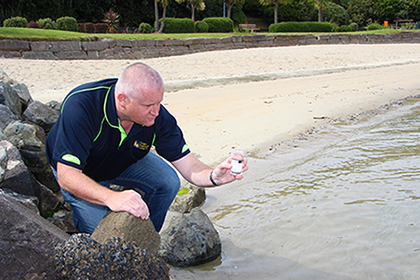
ORC environmental data officer/administrator Mike Cummings tests the recreational water quality at Macandrew Bay.
With summer under way, Otago Regional Council (ORC) has begun its annual recreational water quality monitoring at 17 Otago sites.
ORC director engineering, hazards and science Gavin Palmer said the council monitors bacteria levels in a range of rivers and coastal areas, particularly over summer when people are more likely to swim or fish in local waterways.
"We typically have very good water quality in Otago, and there are loads of great spots to swim and enjoy our lakes and rivers. Sometimes, particularly after heavy rainfall, bacteria levels are increased and may affect the suitability of the water for swimming,” he said.
The most common sources of bacterial infection are human sewage, stormwater, and rural runoff.
Recreational water monitoring runs from 1 December through to 31 March each year. Coastal water is tested for enterococci, while freshwater is tested for Escherichia coli (E coli).
“Towards the end of each week results are uploaded to the ORC and Land and Water Aotearoa (LAWA) websites,” Dr Palmer said.
The test results are compared with national guidelines set by the Ministry for the Environment and the Ministry of Health.
The guidelines recommend a three-tier ‘traffic light’ framework for bacteria counts, with green indicating it should be very safe for swimming, amber safe, and red a possible health risk.
ORC currently monitors recreational water at sites spanning the region from Kaka Point in the south to Clifton in the north-east, Frankton Arm in the west, and Lake Hawea in the north-west.
Otago has been experiencing drier-than-normal conditions recently, and these are likely to continue throughout this summer, due to the El Nino event under way in the Pacific Ocean.
Conditions are expected to be similar to last summer’s (2014-15) low rainfall and river conditions, which resulted in irrigation restrictions for large parts of North Otago and Central Otago.
Given that river flows are likely to be low because of the anticipated dry conditions Dr Palmer advised the public to keep an eye out for toxic algae (cyanobacteria), a group of bacteria common in local waterways at this time of year.
Sometimes called blue-green algae, these bacteria can be toxic to dogs, and cause severe skin irritations to swimmers.
For more information contact
Gavin Palmer
Director engineering, hazards and science
Otago Regional Council
03 474 0827 or 0274 933 960
